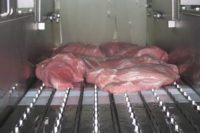This summer, the U.S. Department of Agriculture proposed that mechanically tenderized beef and beef products injected with marinade or solution be labeled due to food-safety concerns. Whether the rule is enacted or not, tenderized beef is now on consumers’ radar.
Tender meat is certainly prized by consumers, who are willing to pay five times more for it, according to the National Cattlemen’s Beef Association.
Meat can be softened through mechanical tenderization, which utilizes hundreds of tiny blades to cut through muscle fibers, or by tenderization with marinades, which are usually injected through hollow needles or meat cuts. Sometimes, meat and marinades are tumbled together inside a rotating drum for a more uniform result. And meat can also be mechanically tenderized and then tumbled with marinades.
The USDA is concerned that pathogens that are on the meat’s surface, such as E. coli0157:H7, may be driven deep into the cut’s center through the tenderization process — in which case, cooking may not kill them.
The Centers for Disease Control and Prevention states there have been five E. colioutbreaks attributed to mechanically tenderized beef, sickening 174 people and causing four people to die.
For its part, the American Meat Institute opposes the labeling, explaining it will only confuse consumers.
Peter Muriana, Ph.D., food microbiologist, Oklahoma State University, is one of several scientists who have worked for years on decreasing the risk of contamination during mechanical tenderization. Muriana’s group has, for example, experimented with spraying the meat surface with antimicrobials to eliminate pathogens before it is cut with blades.
“There was definitely a correlation between beef surfaces sprayed with antimicrobials to those with less pathogen penetration, which is logical,” says Muriana, who also sits on the National Advisory Committee on Microbiological Criteria for Foods. “If you kill off more surface bacteria, then there is less for blades to bring inside.”
Injecting technology into tumblers
Besides following new food-safety procedures, many injectors and tumblers today are equipped with computer systems that make it easy for an operator to adjust speeds and pressure in a user-friendly format.
“This allows for better quality control of the process and it helps in achieving consistent, uniform marinade or brine pickup,” says Rafael Rivera, manager, food safety and production programs, U.S. Poultry & Egg Association (USPOULTRY).
These machines are also improving the refrigeration and recirculation of brines.
“Temperature is a critical component of brine effectiveness,” he says. “These must be kept cold in order to achieve water-binding capabilities in the meat.”
They are also equipped with filters to remove meat pieces and debris from the re-circulating brine.
“Advances in water filtration are also being incorporated since water hardness can cause lower-quality brine or marinades and can deliver inconsistent water-binding capabilities and affect flavoring,” says Rivera.
Reducing sodium in brines
Processors are trying to reduce sodium in brines and marinades, but they can’t cut it out completely because salt helps bind water to the muscle and it enhances flavoring.
“Processors are making adjustments such as using sea salt, among other salts that have a lower sodium content, that can achieve similar results to the ingredients used in the past,” says Rivera.
He notes that processors are also using herbs, spices and other aromatic components to either add or mask flavors. “These formulations vary from company to company depending on their product mix,” he says.
Meat companies, such as sausage and emulsified sausage manufacturers, are also employing salt-reduction strategies, notes Jeff Sindelar, associate professor and extension meat specialist, University of Wisconsin-Madison.
“There are a few different approaches: physically reduce salt, replace sodium chloride with other ingredients [such as use a portion of a sodium chloride formulation with potassium chloride] and examine the sodium molecule itself to better understand how other molecules interact with sodium to enhance the salt flavor,” he says.
Many companies are also focusing on where sodium is introduced into the system, such as with sodium nitrites, sodium phosphates and sodium lactates, that contribute small but significant amounts of sodium, says Sindelar.
In general, technological advances have allowed brines and marinades to be more effective, he says. “Companies can better take into account a product’s consistency, shape, size and ability to take and retain brine today,” notes Sindelar.





Report Abusive Comment